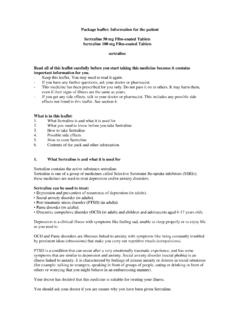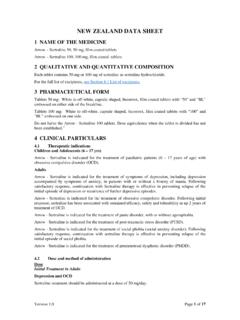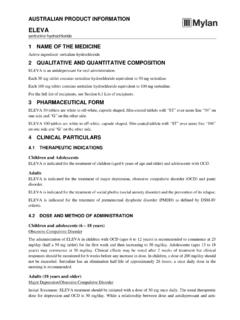Transcription of DATA SHEET PRODUCT NAME - Medsafe
1 Page 1of 15 data SHEET 1. PRODUCT name JANUVIA 25 mg film - coated tablets JANUVIA 50 mg film - coated tablets JANUVIA 100 mg film - coated tablets 2. QUALITATIVE AND QUANTITATIVE COMPOSITION Each JANUVIA 25 mg tablet contains sitagliptin phosphate monohydrate, equivalent to 25 mg sitagliptin. Each JANUVIA 50 mg tablet contains sitagliptin phosphate monohydrate, equivalent to 50 mg sitagliptin. Each JANUVIA 100 mg tablet contains sitagliptin phosphate monohydrate, equivalent to 100 mg sitagliptin. For the full list of excipients, see section 3. PHARMACEUTICAL FORM 25 mg tablet: A pink round film - coated tablet with 221 on one side and plain on the other. 50 mg tablet: A light beige round film - coated tablet with 112 on one side and plain on the other.
2 100 mg tablet: A beige round film - coated tablet with 277 on one side and plain on the other. 4. CLINICAL PARTICULARS Therapeutic indications Monotherapy JANUVIA is indicated as an adjunct to diet and exercise to improve glycaemic control in adult patients with type 2 diabetes mellitus. Combination with metformin JANUVIA is indicated in patients with type 2 diabetes mellitus to improve glycaemic control in combination with metformin as initial therapy or when diet and exercise, plus the single agent do not provide adequate glycaemic control. Combination with a sulfonylurea JANUVIA is indicated in patients with type 2 diabetes mellitus to improve glycaemic control in combination with a sulfonylurea when treatment with the single agent alone, with diet and exercise, does not provide adequate glycaemic control.
3 Combination with a PPAR agonist JANUVIA is indicated in patients with type 2 diabetes mellitus to improve glycaemic control in combination with a PPAR agonist ( thiazolidinediones) as initial therapy or when the single agent alone, with diet and exercise, does not provide adequate glycaemic control. Page 2of 15 Combination with metformin and a sulfonylurea JANUVIA is indicated in patients with type 2 diabetes mellitus to improve glycaemic control in combination with metformin and a sulfonylurea when dual therapy with these agents, with diet and exercise, does not provide adequate glycaemic control. Combination with metformin and a PPAR agonist JANUVIA is indicated in patients with type 2 diabetes mellitus to improve glycaemic control in combination with metformin and a PPAR agonist ( thiazolidinediones) when dual therapy with these agents, with diet and exercise, does not provide adequate glycaemic control.
4 Combination with insulin JANUVIA is indicated in patients with type 2 diabetes mellitus as an adjunct to diet and exercise to improve glycaemic control in combination with premixed or long/intermediate acting insulin (with or without metformin). Dose and method of administration The recommended dose of JANUVIA is 100 mg once daily as monotherapy or as combination therapy with metformin, a sulfonylurea, insulin (with or without metformin), a PPAR agonist ( thiazolidinediones), metformin plus a sulfonylurea, or metformin plus a PPAR agonist. JANUVIA can be taken with or without food. When JANUVIA is used in combination with a sulfonylurea or with insulin, a lower dose of sulfonylurea or insulin may be considered to reduce the risk of sulfonylurea- or insulin-induced hypoglycaemia (See Special warnings and precautions for use, Hypoglycaemia in Combination with a Sulfonylurea or with Insulin).
5 If a dose of JANUVIA is missed, it should be taken as soon as the patient remembers. A double dose of JANUVIA should not be taken on the same day. Patients with renal impairment Because there is a dosage adjustment based upon renal function, assessment of renal function is recommended prior to initiation of JANUVIA and periodically thereafter. For patients with mild renal impairment (estimated glomerular filtration rate [eGFR] 60 mL/ m2 to < 90 mL/ m2), no dosage adjustment for JANUVIA is required. For patients with moderate renal impairment (eGFR 45 m2 to < 60 mL/ m2), no dosage adjustment for JANUVIA is required.
6 For patients with moderate renal impairment (eGFR 30 mL/ m2 to < 45 mL/ m2), the dose of JANUVIA is 50 mg once daily. For patients with severe renal impairment (eGFR 15 mL/ m2 to < 30 mL/ m2) or with end-stage renal disease (ESRD) (eGFR < 15 mL/ m2), including those requiring haemodialysis or peritoneal dialysis, the dose of JANUVIA is 25 mg once daily. JANUVIA may be administered without regard to the timing of dialysis. Patients with hepatic impairment No dosage adjustment is necessary for patients with mild to moderate hepatic impairment. JANUVIA has not been studied in patients with severe hepatic impairment.
7 Elderly No dosage adjustment is necessary for elderly patients. Page 3of 15 Paediatric population There are no data available on the use of JANUVIA in patients younger than 18 years of age. Therefore, use of JANUVIA in paediatric patients is not recommended. Contraindications JANUVIA is contraindicated in patients who are hypersensitive to any components of this PRODUCT (See Special warnings and precautions for use, Hypersensitivity Reactions and Adverse effects, Postmarketing Experience). Special warnings and precautions for use General JANUVIA should not be used in patients with type 1 diabetes or for the treatment of diabetic ketoacidosis.
8 Pancreatitis: There have been reports of acute pancreatitis, including fatal and non-fatal haemorrhagic or necrotising pancreatitis (see Undesirable effects), in patients taking sitagliptin. Patients should be informed of the characteristic symptom of acute pancreatitis: persistent, severe abdominal pain. Resolution of pancreatitis has been observed after discontinuation of sitagliptin. If pancreatitis is suspected, JANUVIA and other potentially suspect medicinal products should be discontinued. Use in patients with renal impairment: JANUVIA is renally excreted. To achieve plasma concentrations of JANUVIA similar to those in patients with normal renal function, lower dosages are recommended in patients with eGFR< 45 mL/ m2, as well as in ESRD patients requiring haemodialysis or peritoneal dialysis (See Dose and method of administration, Patients with renal impairment).
9 Hypoglycaemia in combination with a sulfonylurea or with insulin: In clinical trials of JANUVIA as monotherapy and as part of combination therapy with agents not known to cause hypoglycaemia ( metformin or a PPAR agonist (thiazolidinedione)), rates of hypoglycaemia reported with JANUVIA were similar to rates in patients taking placebo. As is typical with other anti-hyperglycaemic agents, when JANUVIA was used in combination with a sulfonylurea or with insulin, medications known to cause hypoglycaemia, the incidence of sulfonylurea- or insulin-induced hypoglycaemia was increased over that of placebo (see Undesirable effects).
10 Therefore, to reduce the risk of sulfonylurea- or insulin-induced hypoglycaemia, a lower dose of sulfonylurea or insulin may be considered (see Dose and method of administration). Hypersensitivity reactions: There have been postmarketing reports of serious hypersensitivity reactions in patients treated with JANUVIA. These reactions include anaphylaxis, angioedema, and exfoliative skin conditions including Stevens-Johnson syndrome. Because these reactions are reported voluntarily from a population of uncertain size, it is generally not possible to reliably estimate their frequency or establish a causal relationship to medicine exposure.













